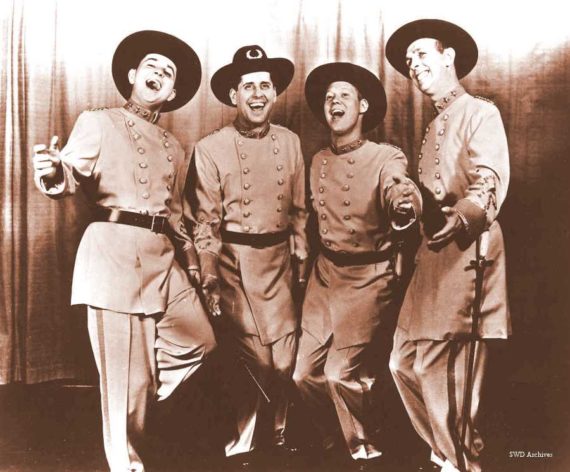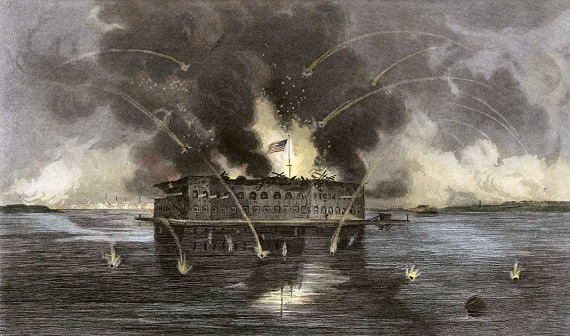Once upon a time in America, in a far different and far more gentle age, it was possible for four young men from Memphis, Tennessee, to appear at a performance in a Northern city dressed as Confederate officers and sing a song entitled “Save Your Confederate Money Boys, the South Shall Rise Again” without being booed off the stage. Not only that, rather than their performance at the 1956 International Quartet Singing Contest in Minneapolis, Minnesota, being met by a mob of screaming, placard-carrying protesters, the quartet, the Confederates, became that year’s gold medal winners. In that bygone era of our nation’s kinder past, such things were entirely acceptable, but in today’s politically correct and racially charged society anything that relates to the Confederacy, from songs, memorial statues and flags to place names, t-shirts and bumper stickers, have become anathema to a large section of the population in the North and, sadly enough, to many in the South as well. Even in the Confederate’s home state of Tennessee, there is now a theater in Nashville that has felt it politically expedient to cause their annual showing of a highly-acclaimed, Academy Award-winning film to be, like the movie’s title, gone with the wind.
Furthermore, as that song by the Confederates so aptly predicted more than half a century ago, the South has indeed risen again, and has today become the new hub of American industry, transportation and capital investment, both domestic and foreign . . . the latter most notably from two other nations that also managed to rise from the ashes of war’s devastation, Japan and Germany. There is, of course, another prophetic aspect of the Confederate’s song that appeared in it’s title . . . the saving of Confederate money. Rather than being ostracized and banned from public view, Confederate currency is now eagerly sought by collectors in every section of America. During the War Between the States, such money was of little actual worth in the South and had absolutely no value outside the Confederacy . . . and after the War it became the butt of endless jokes and a simile for utter worthlessness. Today, however, if the Confederate dollar were to be traded on today’s monetary exchange markets, it would be pegged at an average of one to a hundred Yankee dollars.
For certain of the more rare, higher-denominated Confederate bills, such as the 1861 thousand dollar, interest-bearing note printed in Montgomery, Alabama, the value is now astronomical. Only a little over six hundred of these bills were actually issued, and a genuine, uncirculated specimen would now be worth well over thirty thousand dollars. In the same year, the first of the two five hundred dollar notes that were printed by the Confederacy were issued, and again only about six hundred were put into circulation. These too are just as highly prized by collectors, and in mint condition one would also sell today for over thirty thousand dollars. Furthermore, even though almost a hundred and seventy thousand of the second five hundred dollar notes were issued in 1864, this one bearing a likeness of Stonewall Jackson, an uncirculated one today would be valued at over a thousand dollars. The same situation holds true for Confederate postage stamps, most of which now sell for many times their face value of a few cents.
Aside from notaphily and philately, the collecting of Confederate military goods is also a very popular hobby among many Americans North and South. Unfortunately, while such activity was within the reach of the average enthusiast’s budget in the years prior to the centennial of the War Between the States, it is now generally a hobby for only the very wealthy. Genuine Enfield Tower rifles that were run through the blockade from England and widely used by the Confederate troops were once plentiful on the post-war market, with the Bannerman arms store on lower Broadway in New York City still selling them for under a hundred dollars apiece well into the Twentieth Century. Today, such a weapon, if genuine, would be a bargain at five thousand dollars, and the same holds true for all other Confederate firearms and militaria. In the case of handguns, such as the Northern-made Colt, Remington and Starr percussion pistols, as well as imports like the French LeMat and LeFaucheux pin fire revolvers, while those used by the Union forces now sell for as much as several thousand dollars, any used by the Confederacy would bring many times that price. Handguns manufactured in the South, on the other hand, such as the Georgia-made Griswold and Gunnison percussion revolvers, are now worth up to a million or more dollars. Even though the flags of the Confederacy are being spat on as they are being hauled down all over America, such banners are seen quite differently in the eyes of those who consider them symbols of both history and heritage, as well as treasured collector’s items.
The same would be the case in connection with all other types of Confederate military paraphernalia and memorabilia, with an example of the latter being souvenirs made from the iron plating and wood of the “C.S.S. Virginia.” In the late Nineteenth Century, various such pieces were produced and sold for a few dollars each, such as the metal paperweights made by the Bannerman arms store. Each of these bore the incorrect and misspelled inscription “MADE FROM ARMOR PLATE – CONFEDERATE RAM MERRIMAC,” and were priced at only five dollars. While one of these paperweights sold last year at auction for almost two hundred dollars, most such items are now in museums or private collections and virtually unseen on today’s open market. In reference to Bannerman’s misidentification of the “C. S. S. Virginia,” this error was quite commonplace in Northern lithographs during the War, as well as schoolbooks into the early Twentieth Century. Returning to the Bannerman store, in the 1950s there was a Confederate battle flag there, replete with various colored campaign ribbons and marked “General Lee’s flag,” that was being offered for sale at a mere one thousand dollars. It is very possible that this banner was actually the battle flag of the 53rd Virginia Infantry Regiment that was captured at Gettysburg which Bannerman sold much later to a private collector for five thousand dollars, and is now on display at the Museum of the Confederacy in Richmond. At present, of course, a flag of this type would be considered by most, but sadly not all, as a highly valued piece of America’s past. Such a banner would be the battle flag of the 9th Virginia Infantry Regiment bearing the state’s “sic semper tyrannis” seal that was also captured at Gettysburg. This flag was purchased in 2006 for just under sixty thousand dollars.
All of the current controversy over the South in general, and the Confederacy in particular, brings to mind an idiomatic phrase that was coined by the German author, Leonhard Culmann, in his Sixteenth Century primer, “Sentences for Children,” in which he advised that one man’s weal is another man’s bane. While this admonition has gone through many transformations over the centuries, its original sense that one society’s treasures may well be considered another’s trash is still all too accurate when eying today’s uncivil war. In the current struggle, one side considers the history and heritage of the Confederacy and its leaders, as well as all its varied symbols, to be a veritable treasure chest containing an invaluable and vital portion of America’s past . . . while their opponents look upon such things as nothing more than a pit of shame filled with Southern trash tainted by a history of slavery and racism.
One then wonders if such differences can ever be resolved, and all Americans can once again just sit back, relax and enjoy a performance by a group such as the Confederates. To do this, however, those who now wish to expunge the Confederacy from the history books would have to actually study such volumes written by authors in both camps, and then they might conceivably be able to grasp the simple fact that the unfortunate rattling of slavery’s chains and the stain of racial, ethnic and religious bigotry are not sounds and sights unique to the South, but have been an integral part of American history since our nation’s very inception.







